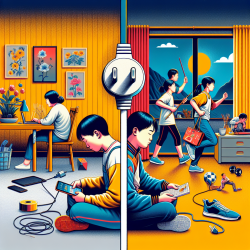Introduction
In the field of neuroimaging and brain connectivity, understanding the effects of gliomas on brain networks is crucial for practitioners aiming to enhance therapeutic strategies. The research article "Brain Functional Connectivity in Low- and High-Grade Gliomas: Differences in Network Dynamics Associated with Tumor Grade and Location" provides insights into how gliomas impact brain connectivity, offering valuable information for clinicians and therapists. This blog post will explore the key findings of the study and suggest ways practitioners can apply this knowledge in their practice.
Key Findings from the Study
The study investigates how low-grade gliomas (LGG) and high-grade gliomas (HGG) affect brain connectivity using resting-state functional magnetic resonance imaging (fMRI) and graph theory. The research highlights several important points:
- Network Efficiency: LGG tends to increase the efficiency of the surrounding functional network, suggesting a potential for adaptive reorganization. In contrast, HGG appears to disrupt connectivity in remote areas, indicating maladaptive changes.
- Tumor Location Impact: The location of the tumor influences the pattern of reorganization. Frontal and temporal tumors show bilateral modifications, while parietal and insular tumors exhibit more localized effects.
- Clinical Implications: The study suggests that LGG may lead to more favorable connectivity changes, reflecting fewer clinical deficits compared to HGG.
Practical Applications for Practitioners
For practitioners, these findings offer a pathway to refine therapeutic approaches and improve patient outcomes. Here are some strategies to consider:
- Targeted Therapy: Understanding the specific network changes associated with different tumor grades and locations can help tailor therapies to enhance recovery. For instance, therapies that promote adaptive reorganization in LGG patients could be prioritized.
- Monitoring and Assessment: Utilizing fMRI and graph theory metrics can aid in monitoring the effectiveness of interventions and adjusting treatment plans accordingly. Practitioners can use these tools to track changes in brain connectivity and identify potential maladaptive patterns.
- Interdisciplinary Collaboration: Collaborating with neuroimaging specialists can provide deeper insights into individual patient cases, allowing for more personalized and effective treatment strategies.
Encouraging Further Research
The study underscores the complexity of brain connectivity changes in glioma patients and the need for further research. Practitioners are encouraged to engage in or support research efforts to better understand the nuances of functional reorganization. This could involve participating in clinical trials, contributing to data collection, or collaborating with research institutions.
Conclusion
Understanding the dynamics of brain connectivity in glioma patients is essential for developing effective therapeutic strategies. By applying the insights from this study, practitioners can enhance their skills and improve patient care. For those interested in delving deeper into the research, the original paper provides a comprehensive analysis of the findings and methodologies.
To read the original research paper, please follow this link: Brain Functional Connectivity in Low- and High-Grade Gliomas: Differences in Network Dynamics Associated with Tumor Grade and Location.










